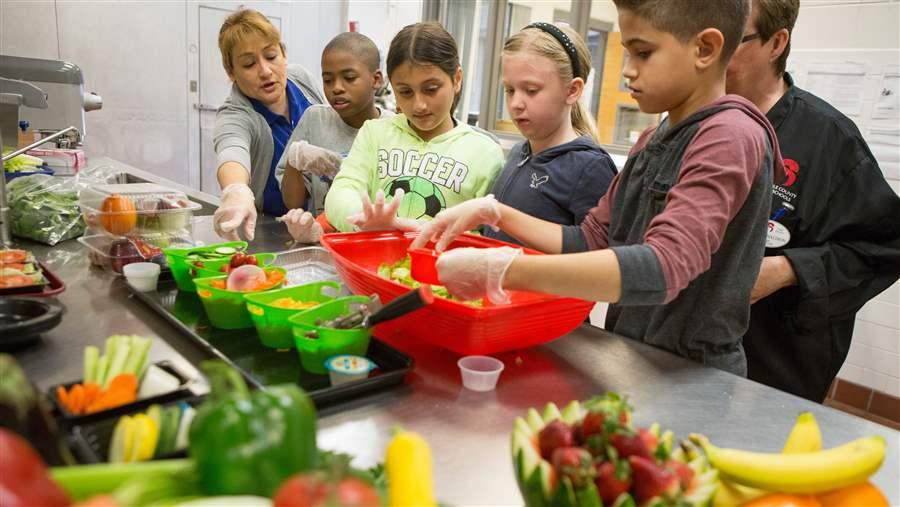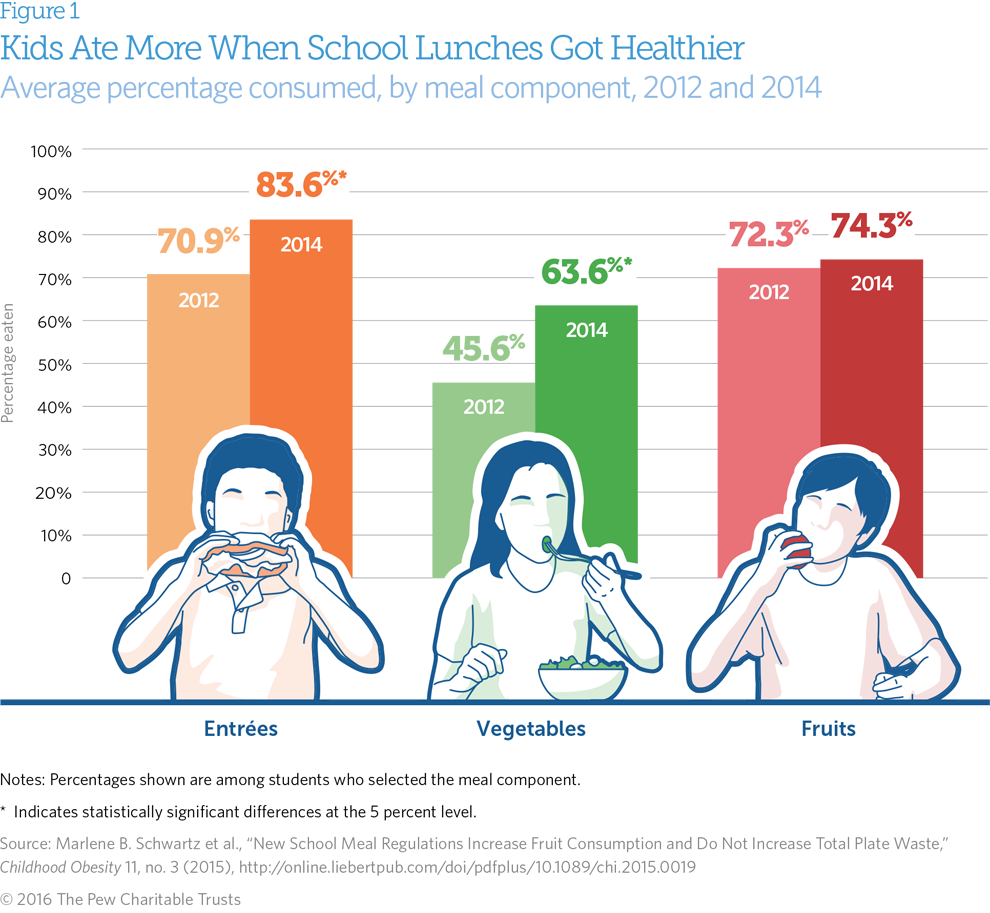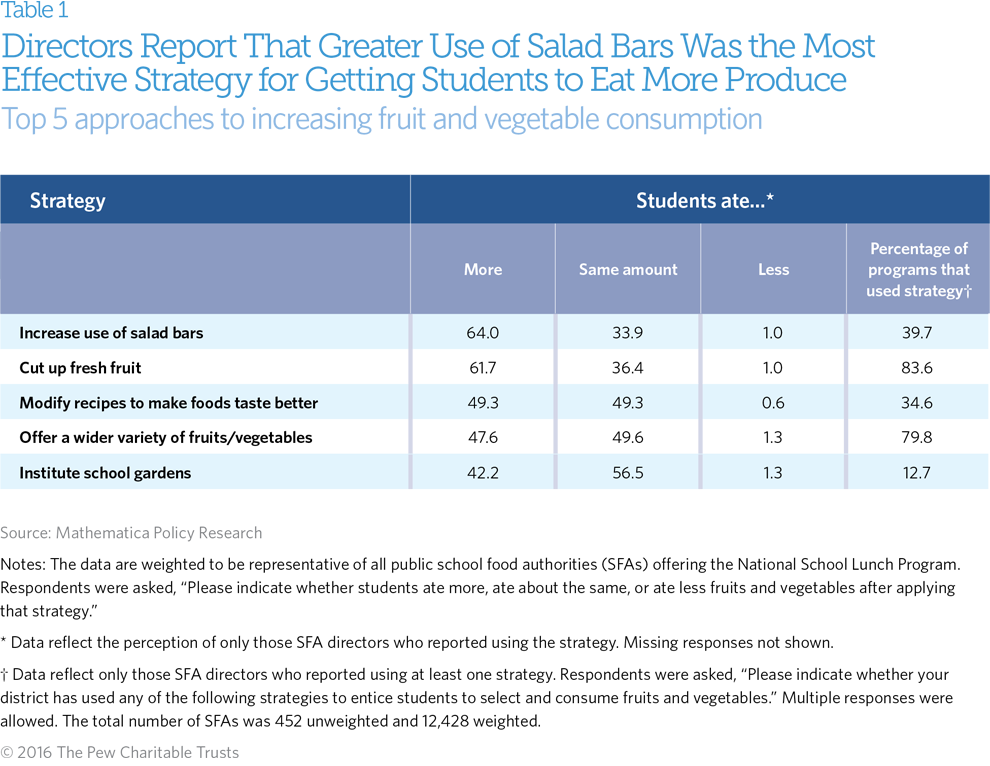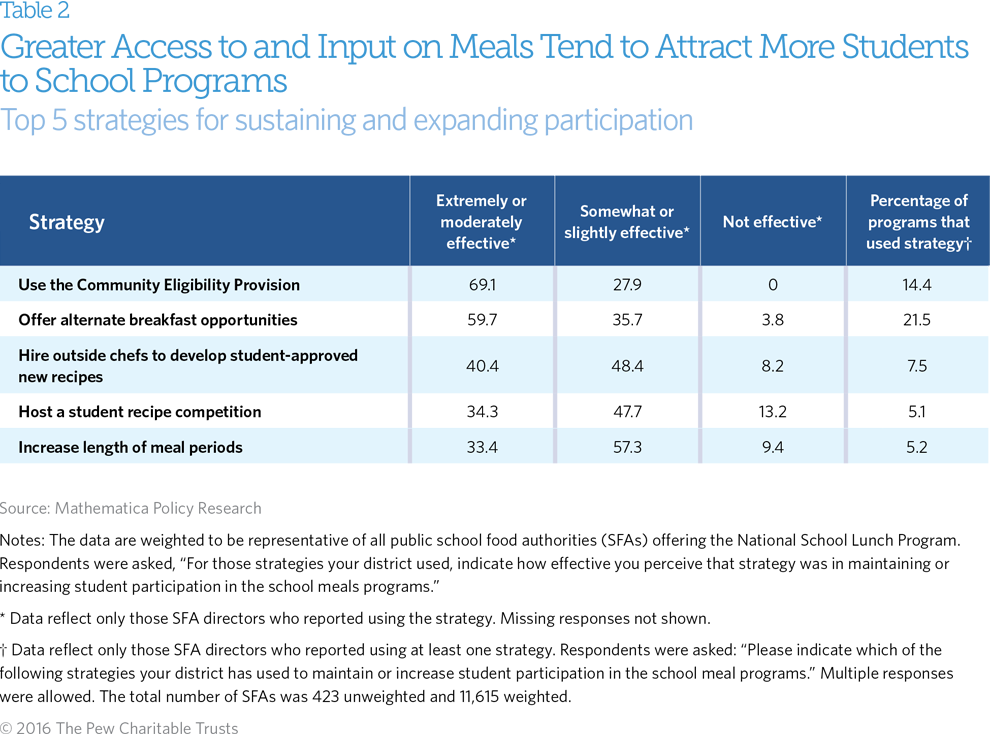Schools Embrace Proven Strategies to Promote Students’ Healthy Eating
Nutrition directors encourage involving kids in food choices, expanding meal service beyond the cafeteria
Overview
Schools play a critical role in delivering hands-on experiences that help children develop healthy eating habits and find nutritious foods they enjoy. Students receive meals, snacks, and drinks from cafeterias, vending machines, and stores thousands of times during their K-12 years. Since the 2012-13 school year (SY), districts nationwide have raised the nutritional quality of their offerings across these venues to better support children’s health, readiness to learn, and lifelong eating habits.1 Multiple studies show significant progress toward these goals: Kids are selecting more nutritious meals and eating more fruits and vegetables.2 (See Figure 1.)
To examine how school meal programs have encouraged good decisions among their students, the Kids’ Safe and Healthful Foods Project—a joint initiative of The Pew Charitable Trusts and the Robert Wood Johnson Foundation—commissioned a nationally representative sample of school nutrition department directors. The project also gathered insights on the survey data from a panel of school nutrition leaders whose districts are recognized for their success in serving healthy meals and snacks.3 The research makes clear that multiple strategies, particularly those that engage children’s creativity and invite their input, have helped instill healthy eating behaviors at schools across the country.
Directors say salad bars, sliced fruit are best for increasing produce consumption
Nutrition staff in 92 percent of meal programs use at least one strategy and, on average, a blend of four to encourage students to eat more fruits and vegetables. The survey asked respondents to assess the effects of each strategy. (See Table 1.) The key findings include:
- Most directors who increased the use of salad bars or served pre-cut fresh fruit said that children ate more fruits and vegetables as a result.
- Adjusting recipes to enhance taste and giving kids more choices yielded higher consumption in about half of the programs that tried either approach.
- By contrast, large majorities of directors reported that promotional signage and changes to the display of fruit did not, by themselves, increase the overall amount eaten.
Expanded meal service, recipes developed with students or chefs help participation rates
The survey found that nutrition directors used an average of five and as many as 17 strategies to maintain or increase student participation in meal programs during the transition to healthier national standards. (See Table 2.) The key findings about the effectiveness on these strategies included:
- Most respondents who expanded breakfast service to classrooms, buses, or times after the school day’s first bell saw significant participation benefits.
- For eligible schools, enrolling in the Community Eligibility Provision (CEP) of the Healthy, Hunger-Free Kids Act of 2010 earned high marks for providing more students access to healthy meals.4 The provision allows schools with large percentages of low-income children to offer breakfasts and lunches at no charge without collecting free and reduced-price meal applications from each family.
- Recipe collaborations with students or hired chefs and more time to eat also produced improvements for many of the programs using those strategies.
Panelists’ keys to success
All the panel members have maintained or expanded their programs’ student participation and revenue since 2012. Their discussion of the survey results and personal experiences produced a list of six C’s—values they have used to encourage children’s enjoyment of healthy school meals.
Culture
- Treat the cafeteria as a restaurant and the students as customers. Offer more of the most popular menu items.
- Train nutrition staff to think of the school meal programs as a business that requires an investment in quality ingredients and appealing foods.
Creativity
- Engage students through a menu-planning challenge in which they can design healthy meals, market them to classmates, and ultimately have their creations served in the cafeteria.
- Explore nontraditional ways to offer reimbursable meals to students, such as through vending machines, to attract new customers.
Collaboration
- Partner with other districts to identify needs and provide joint trainings.
- Work with administrators to expose children to aspects of the school meals program they may be less familiar with, such as taking students on a morning tour of the cafeteria to learn about the breakfast program.
Communication
- Use social media to connect with parents about the benefits of the school meal program.
- Educate administrators on the importance of school meals in contributing to student wellness and academic achievement.
Consistency
- Innovate regularly by adding new menu items that keep students’ enthusiasm high.
- Examine participation numbers often (at least monthly) and review menu items to replace unsuccessful options.
Celebration
- Invite local media to a special event in the school meals program.
- Share success stories with administrators, parents, and the community.
Endnotes
- Starting in SY 2012-13, schools participating in the National School Lunch Program were required to meet healthier meal standards set by the U.S. Department of Agriculture. Updated standards for the School Breakfast Program took effect in SY 2013-14. Stronger guidelines for food and drinks sold a la carte from cafeterias, vending machines, and stores or as fundraisers during the school day were put in place in SY 2014-15.
- Juliana F.W. Cohen et al., “Impact of the New U.S. Department of Agriculture School Meal Standards on Food Selection, Consumption, and Waste,” American Journal of Preventive Medicine 46, no. 4 (2014): 388–94, http://dx.doi.org/10.1016/j.amepre.2013.11.013; Marlene B. Schwartz et al., “New School Meal Regulations Increase Fruit Consumption and Do Not Increase Total Plate Waste,” Childhood Obesity 11, no. 3 (2015): 242–7, http://dx.doi.org/10.1089/chi.2015.0019; Karen W. Cullen, Tzu-An Chen, and Jayna M. Dave, “Changes in Foods Selected and Consumed After Implementation of the New National School Lunch Program Meal Patterns in Southeast Texas,” Preventive Medicine Reports 2 (2015):440–3, http://dx.doi.org/10.1016/j.pmedr.2015.05.007; and Donna B. Johnson et al., “Effect of the Healthy Hunger-Free Kids Act on the Nutritional Quality of Meals Selected by Students and School Lunch Participation Rates,” JAMA Pediatrics 170, no. 1 (2016) (online only), http://dx.doi.org/10.1001/jamapediatrics.2015.3918.
- Mathematica Policy Research gathered responses from a nationally representative sample of public school food authorities (SFAs) for the Kids’ Safe and Healthful Foods Project. The questionnaire was designed to collect information on the continued challenges and successes achieved related to the ongoing implementation of the USDA’s nutrition standards for school meals and snacks. Directors from 489 SFAs completed the survey at the end of SY 2014–15, so when the data for this study were collected, all of the updated meal requirements were in effect. Data were weighted to be nationally representative of all public SFAs participating in the NSLP in SY 2014–15, and the weighted response rate was 52 percent.
- U.S. Department of Agriculture, “School Meals: Community Eligibility Provision,” accessed Jan. 27, 2016, http://www.fns.usda.gov/schoolmeals/community-eligibility-provision. The Community Eligibility Provision (CEP) of the Healthy, Hunger-Free Kids Act of 2010 allows schools and local education agencies in communities with high poverty rates to provide breakfast and lunch to all students at no cost. The CEP eliminates the burden of collecting applications and determining eligibility for free or reduced-price meals of individual families and instead uses information from other programs, such as the Supplemental Nutrition Assistance Program and Temporary Assistance for Needy Families. USDA phased in the CEP over three years in a limited number of states and made it available nationwide beginning July 1, 2014.














